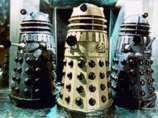 |
|
The Daleks
|
|
 World peace hangs in the balance. Sir Reginald Styles, a high-ranking diplomat is the only person that stands between mankind and a third and final World War. But a mysterious and savage guerrilla force from the 22nd Century believe Styles is the agent that shaped their terrifying future and therefore must die... World peace hangs in the balance. Sir Reginald Styles, a high-ranking diplomat is the only person that stands between mankind and a third and final World War. But a mysterious and savage guerrilla force from the 22nd Century believe Styles is the agent that shaped their terrifying future and therefore must die...
 The Doctor and Jo find themselves flung into the guerrillas' world; a brutal dictatorship policed by the merciless and ape-like Ogrons. The Daleks have invaded Earth, enslaved the population and face certain triumph unless The Doctor betrays all he believes in and condones the cold-blooded murder of Styles in an attempt to change the course of history... irrevocably. The Doctor and Jo find themselves flung into the guerrillas' world; a brutal dictatorship policed by the merciless and ape-like Ogrons. The Daleks have invaded Earth, enslaved the population and face certain triumph unless The Doctor betrays all he believes in and condones the cold-blooded murder of Styles in an attempt to change the course of history... irrevocably.
|
| | Source: BBC VHS Video | |
| Season: |
Nine
|
| Production
Code: |
KKK |
| Story Number: |
60
|
| Episode Numbers: | 304 - 307 |
| Number of
Episodes: |
4 | | Percentage of Episodes Held: | 100% | | Alternative Titles: | "The Day of the Daleks" | | Working Titles: | "The Ghost Hunters", "Years of Doom", "The Time Warriors" and "Ghosts" |
| Production
Dates: |
September - October 1971 |
| Broadcast Started: | 01 January 1972 | | Broadcast Finished: | 22 January 1972 |
| Colour Status: |
Colour and B&W |
|
Studio: |
BBC Television Centre (TC4 and TC8) |
|
Location: |
|
Dropmore Park (Burnham, Buckinghamshire), Harvey House (Brentford, Middlesex) and Bull's Bridge (Hayes, Middlesex). |
|
| Writer: | Louis Marks | | Director: | Paul Bernard | | Producer: | Barry Letts | | Script Editor: | Terrance Dicks | | Editor: | Dan Rae | | Production Assistant: | Norman Stewart | | Assistant Floor Manager: | Sue Hedden | | Designer: | David Myerscough-Jones | | Costume Designer: | Mary Husband | | Make-Up Designer: | Heather Stewart | | Cameraman: | Fred Hamilton | | Lighting: | Alan Horne | | Visual Effects: | Jim Ward | | Fights Arranged By: | Rick Lester | | Incidental Music: | Dudley Simpson | | Special Sounds (SFX Editor): | Brian Hodgson | | Studio Sounds: | Tony Millier | | Title Sequence: | Bernard Lodge and Ben Palmer | | Title Music: | Ron Grainer and the BBC Radiophonic Workshop. Arranged by Delia Derbyshire | | Daleks Originally Created By: | Terry Nation |
| Number of
Doctors: |
1 | | The Doctor: |
|
| Number of
Companions: |
4 | | The Companions: |
|
| Additional Cast: |
|
Wilfrid Carter (Sir Reginald Syles), Jimmy Winston (Shura), Anna Barry (Anat), Scott Fredericks (Boaz), Aubrey Woods (Controller), JeanMcFarlane (Miss Paget), Deborah Brayshaw (Girl Technician), Gypsie Kemp (U.N.I.T. Radio Operator), Tim Condren (Guerilla), Valentine Palmer (Monia), Peter Hill (Manager), Andrew Carr (Senior Guard), George Raistrick (Guard at Work Centre), Rick Lester (Ogron), Maurice Bush (Ogron), David Joyce (Ogron), Frank Menzies (Ogron), Bruce Wells (Ogron), Geoffrey Todd (Ogron), John Scott Martin (Dalek), Ricky Newby (Dalek), Murphy Grumbar (Dalek), Oliver Gilbert (Dalek Voice), Peter Messaline (Dalek Voice), Alex Macintosh (Television Reporter) |
| | Setting: |
|
Auderly House (1970s) and an alternative England (22nd century) |
|
|
Villains: | Daleks and Ogrons
|
| No. |
Episodes |
Broadcast
(UK) |
Duration |
Viewers
(Millions) |
In
Archive |
| 304 | Episode 1 | 01 January 1972 | 23'36" | 9.8 | PAL 2" colour videotape | | 305 | Episode 2 | 08 January 1972 | 23'52" | 10.4 | PAL 2" colour videotape | | 306 | Episode 3 | 15 January 1972 | 24'18" | 9.1 | PAL 2" colour videotape | | 307 | Episode 4 | 22 January 1972 | 24'17" | 9.1 | PAL 2" colour videotape |
| Total Duration |
1 Hour 36 Minutes |
| Average Viewers
(Millions) |
9.6 |
| Doctor Who Magazine Poll (1998) | 67.77%  (Position = 82 out of 159) (Position = 82 out of 159) | | Doctor Who Magazine Poll (2003) | 358 Points (Position = 45 out of 159) | | Doctor Who Magazine Poll (2009) | 73.41%  (Position = 71 out of 200) (Position = 71 out of 200) | | Doctor Who Magazine Poll (2014) | 77.20%  (Position = 65 out of 241) (Position = 65 out of 241) | | Doctor Who Magazine Poll (2023) | Position = 11 out of 24 |
 All four episodes exist in colour as PAL 2" colour videotapes. All four episodes exist in colour as PAL 2" colour videotapes. |
|
|
|
|